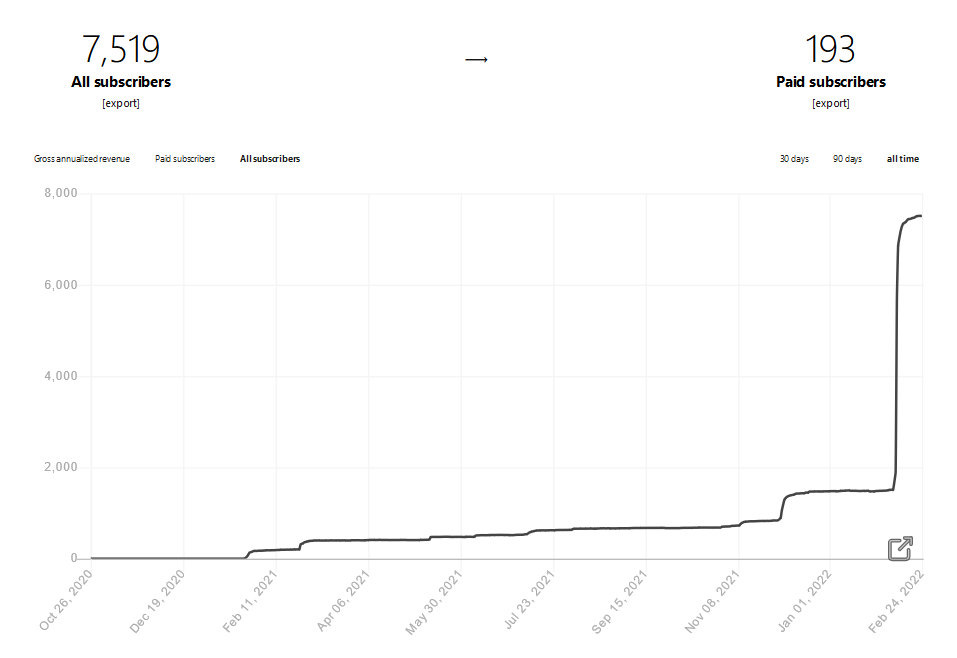This is the continuation of our Grow interview series, designed to share the nuts and bolts of how writers have gone independent and grown their audiences on Substack. It has been lightly edited for length and clarity.
We invited Mike Sowden, who writes Everything is Amazing, to share his insights on cultivating authenticity, promoting “wow” moments, and riding the wave of virality.
What’s your Substack about in one sentence?
The science of curiosity and the endless benefits of a good “wow”.
What do you offer readers?
I am uniquely unqualified to tackle just about everything I write about! I’m not a scientist or a science journalist—I’m just an enthusiast with a bit of experience at telling engaging stories.
But here, I’m open about how I’m learning as I go, and sometimes discovering I’m dead wrong about stuff. When that happens, it’s embarrassing, but it’s important to admit I got something wrong (and also to say “I don’t know”). I think this makes a writer more relatable, which is good for engagement.
So I have to keep reminding myself of my real role here, because when you write thousands of words about a topic, it’s easy to come up with a few conclusions of your own and fall so much in love with them that you end up arguing with people who genuinely know what they’re talking about. So I try to be open about my ignorance, and tell stories that point my readers towards the people and teams doing the real research, without mangling their findings too much along the way.
Growth by the numbers
Started Substack: January 2021
Launched paid subscriptions: August 2021
Free subscribers: 7,519
Paid subscribers: 193
Why did you decide to go paid?
I knew before I started that I wanted this to be a paid newsletter—and I hoped that along the way, I could somehow turn it into my main source of income (which it now is, as of a few weeks ago). But when I started the whole project, it was also an act of self-therapy.
From 2010 to 2014, I was a travel writer—and then I burned out because of stress due to my late mother’s declining health. I completely lost my writing voice, along with my curiosity and enthusiasm for life: a double whammy that left me depressed and took away my ability to do my career and earn a living.
I figured that writing a newsletter about curiosity, and about its role in making you more hopeful and interested in the world, would be great for me and perhaps interesting to anyone reading it. After a year, it’s given me the enthusiasm and optimism and ability to focus that I so desperately wanted back.
Content strategy
Schedule: On my About page I say “once or twice a week,” but sometimes a piece will guzzle up a huge amount of time and energy and I’ll have to keep throwing myself at it until it’s days or a week overdue. Consistency is important, but when it gets in the way of doing a good job, I err on the side of delaying until it’s ready. That extra invested time usually means it’s so much better than it would have been, with a much bigger payoff in social media shares and buzz.
Calendar: I work in seasons, like podcasts or TV shows. This means I can reap the benefits of having regular beginnings and endings to get people excited about upcoming stuff and to do foreshadowing, summaries, and paid subscriber drives to my free list at the end. And also to give myself a rest between seasons! So it’s 8-10 weeks then a break, with part of each season built around a main theme. (The current one is the 71% of our planet we pay too little attention to.) Within those boundaries, it’s very loose—I’m always looking for new experiments to try.
Pricing: When I took part in Substack Grow late last year, I heard the team make the excellent point that subscribers don’t care if you’re charging an extra dollar more than everyone else, because a dollar is “barely-notice-it’s-there” money—so I nudged my monthly price up to $6. Zero complaints so far!
What is the sharpest insight you can offer other writers about growing a Substack publication?
Beware of formulas.
Be wary of anything that makes your output look over-mechanical, and makes you look too much like what other people are doing. You can’t (and shouldn’t) completely ignore what is working for everyone else, but always be looking for your own spin on things, your own creative experiments that might work brilliantly for you and nobody else. This isn’t “looking unprofessional”, this is “looking like an actual person” … which surely is the Holy Grail of newsletter writing.When you’re small, do things that don’t scale.
This is advice from entrepreneur Paul Graham. What’s a personal touch that you can apply that will be impossible to do for time reasons when you’re much bigger in scale? One approach I take is that if someone takes out a paid subscription, I take a few minutes to write them an email by hand, after trying to discover who they are using Google. I can ask an interesting question or two about who they are and what they do.
What advice have you received about growing your publication that didn’t prove to be helpful?
The last time I did a discussion thread in a newsletter, it was total crickets. So either I did it all wrong, or it’s just not a thing that works for me. I know these threads work brilliantly in other Substacks, but it seems so far that my readers prefer leaving comments under normal posts or sending me emails directly. That feels like more proof that you have to experiment until you discover what works for you, because there’s no one-size-fits-all here.
What has been a meaningful moment for the growth of your publication? How did that happen?
In November of last year, I was growing my free list at a slow but steady pace by translating posts with enough “wow” moments to maybe get people’s interest into Twitter threads. I’d done maybe seven or eight such threads since the summer, each one netting me somewhere between 10 and 50 new subscribers.
Then I did one on light pillars, something I knew nothing about until I stumbled over an explanation when searching for examples of cool optical illusions, the theme of season 3. It went viral, reaching a million people, and sending 700 people into my free list. I couldn’t believe it.
So I started 2022 hopeful and optimistic about using Twitter this way, but absolutely sure that lightning would never strike me like that again.
And then I wrote about an incredible event called the “Zanclean Megaflood,” just a couple of weeks ago—and that Twitter thread went mind-bendingly bananas. That series of tweets reached 9 million people, and has given me over 6,000 free newsletter subscribers and over a hundred paying ones. I’m still reeling from this.


For my own sanity and to keep my ego in check, I have to assume this is mostly freak luck. I found a really cool science story, and I just got madly lucky with the way I told it. But will I be trying to do something like that again? You bet.
Takeaways
Follow what excites you. Mike covers subjects that get him interested and excited. That energy not only keeps him going, but shines through in the authentically human voice and tone of his writing, which helps to transmit his enthusiasm to readers.
Set a strategic schedule. Mike organized his publication calendar around seasons, which creates a natural rhythm for both rest and promotion. In between seasons, Mike can take a moment to slow down and recharge. And, when a new season launches, it’s a natural inflection point to get the word out and drum up fresh excitement.
Lean into “wow” moments. When using Twitter or other social media platforms to promote your writing, think about highlighting the unique angles that will make readers take notice. Mike has found success utilizing Twitter threads with sharp leads.
What questions do you have for Mike that we didn’t ask? Leave them in the comments!
To read more from this series on growing your publication, see our interviews with Elizabeth Held, Jonathan Nunn, Polina Pompliano, Michael Williams, Judd Legum, and Caroline Chambers.







Share this post